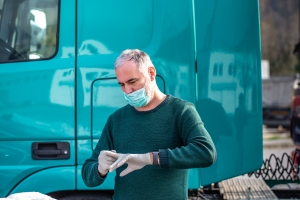
From seasonal spikes to ever-increasing customer expectations, the trucking industry has always sought to conform with the times. But what happens when our industry is met with a time that is unprecedented for everyone? Enter COVID-19. Since December 2019, the virus has rapidly spread throughout the world, resulting in 3.7 million cases as of May 6.
Given the virus, there has been a substantial increase in essential — and nonessential — demand for items. In terms of essential items in grocery stores, rising numbers and shelter-in-place orders have resulted in many people shopping online or buying in bulk to avoid frequent shopping. Some grocery stores have struggled to keep up with demand, while others are altering and expanding their services to meet customer demands via deliveries or pick-up orders.
Retail chains and non-essential small businesses, on the other hand, have all but shut down their in-store operations across the country. While many have shifted their focus to online sales exclusively, they still struggle to compete with giants in the online shopping industry, like Amazon. Extreme unemployment will continue to significantly hinder demand in these areas.
With that preface, what does this combination of high demand in some areas, lack of demand in other areas, and ample rising unemployment mean for the trucking industry in the U.S.? The short answer? It’s complicated.
Long haul vs. last mile
The American Transportation Research Institute (ATRI) and the Owner-Operator Independent Driver Association (OOIDA) recently released critical research on the impact that the COVID-19 pandemic is having on all aspects of the trucking industry.
In their research, ATRI and OOIDA found that long-haul trips are down considerably. The likely cause of this — based off of anecdotal evidence — is due to the decreased movements of international containers, which are attributed to rampant travel restrictions and economic priorities.
On the same note, last mile trips under 100 miles have increased by 100%. Much of this can be attributed to the nature of last mile deliveries, paired with the fact that many last mile vehicles are dealing with far less traffic on the road. What’s more, essential entities seeing a rise in demand — like grocery stores and pharmacies — make up many last mile deliveries. If you work in the last mile space and could use some help navigating through a surge in deliveries, check out Omnitracs Routing and Omnitracs Strategic Planner.
Where does driver satisfaction stand?
According to the ATRI and OOIDA, truck drivers are experiencing far less congestion on the road due to shelter-in-place orders. Larger fleets are also experiencing difficulties finding truck parking nowadays, with nearly 50% of these drivers saying parking is much harder to find. If you’re having trouble finding truck parking, take a look at these helpful apps.
Still, truck drivers are focused on getting the job done. New data published on driver satisfaction found that 78% of truck drivers were optimistic about fleet support and the state of their jobs. While the majority of these drivers acknowledged the mental, physical, and economic strain associated with COVID-19, they have still remained focused on the significance of their jobs to the American economy — something they take special pride in.
Tuning in to fleet operations, by the numbers
Based off of the research conducted by the ATRI and OOIDA, nearly 70% of specialized and tank-truck operations have been negatively impacted by COVID-19. In line with this, smaller fleets reported substantial negative impacts in comparison with larger fleets.
In addition, 40% of respondents with fleets containing fewer than five trucks reported decreased average trip lengths, with nearly one in four reporting their average trip length has been much lower than before. On a surprising other hand, 28% of research respondents said their freight levels have remained about the same during the pandemic.
One of the most significant findings was that over 68% of surveyed industry professionals described operations between somewhat lower to much lower. The largest industry sector that has experienced an increase in freight volume has been the trucking industry, signifying that trucking is the largest target for consumer goods and medical supplies.
If you’re in the mood for more blog reading, read our recent blog post on the special relationship between business and freight amidst COVID-19, and don’t forget to keep checking in to our Road Ahead Blog for weekly COVID-19 hot topics.